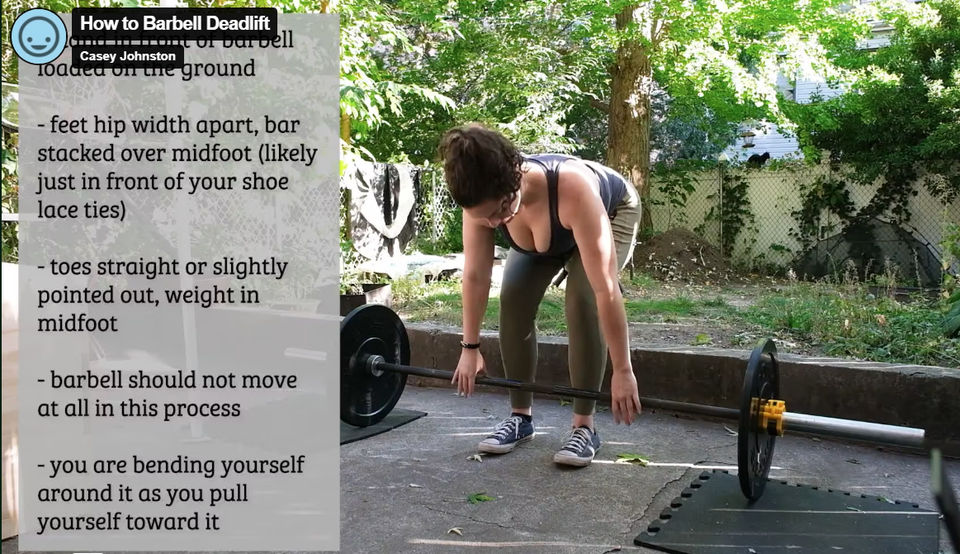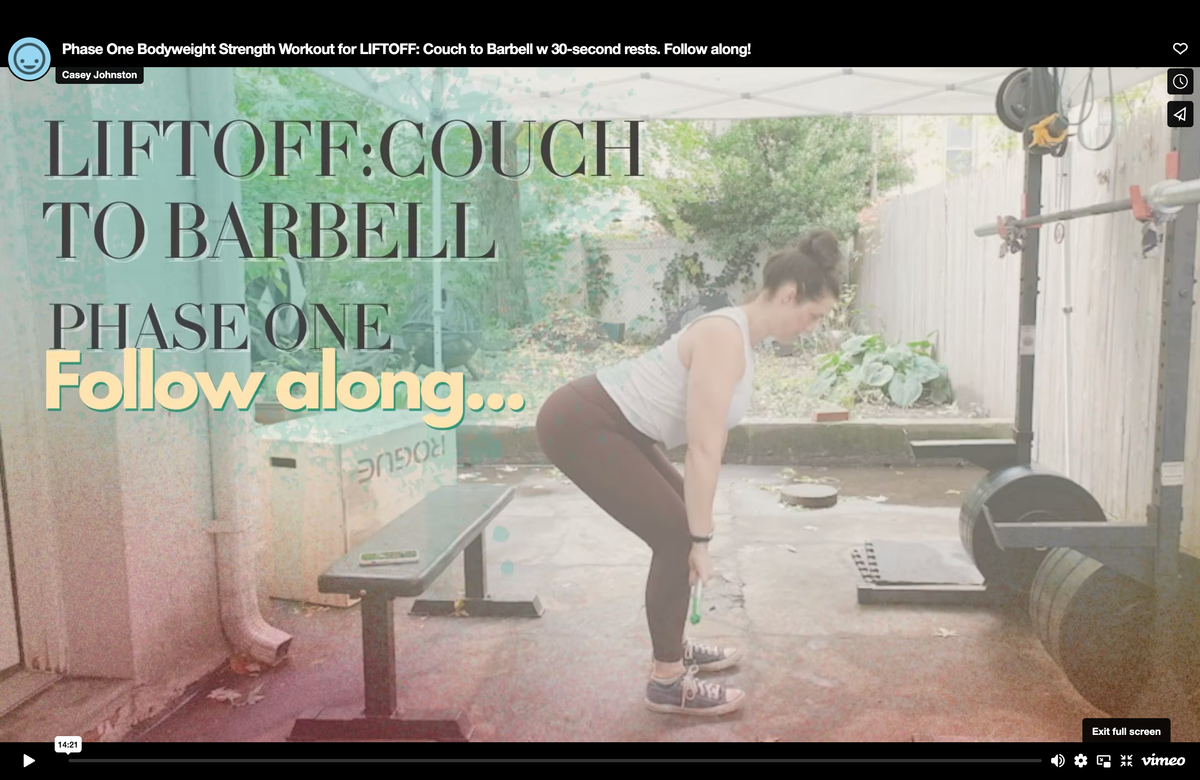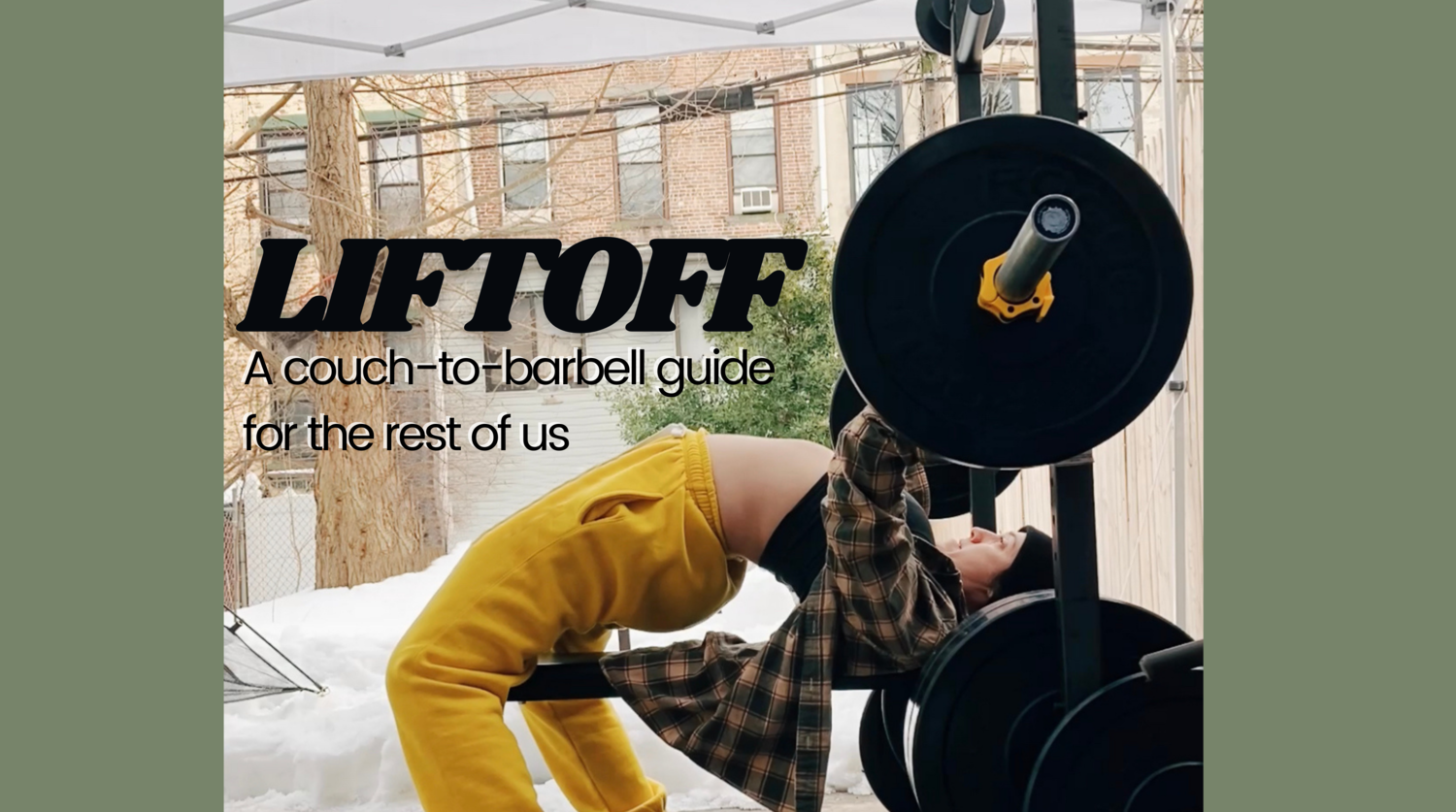Everything you wanted to know about LIFTOFF: Phase Three but were too afraid to ask

Before we get going, I have a present for you! You all have shown the avocado diagrams so much love that I decided to make a little mini zine, just for them. You can print it at home on a single sheet of paper and fold it yourself (no staples required, though you might need some scissors; instructions here). Download the PDF file below!
If you have been following along with the LIFTOFF journey since the beginning of the year (Phase One, Phase Two), here we are: the final Phase of the LIFTOFF program (paper, ebook). Phase Three is where we transition to the use of barbells in a rack for benching, squatting, deadlifting, and overhead press, and also use them for rows.
Barbells are, admittedly, frightening in their weight and dimensions to the unseasoned gym newb: 45 pounds, seven feet long, and made of iron. If you bonk them off of any surface, they will clang loudly. At first blush, they seem more like a medieval weapon to be wielded by an oversize Viking than a piece of workout equipment.
If you ever tried to handle a barbell before, you might have been immediately humbled by its shape and size. But now that you’ve been through eight-plus weeks of weight training, you might be surprised to find that the barbell submits to your touch way more easily than before.
I can’t recommend enough my guides to starting to go to the gym, if you find them daunting. Gyms are daunting! They are unlike many other places we go in their little mores and customs. But we’d find grocery stores similarly daunting if we didn’t have to go regularly. The second time will never be harder than the first, and the third time will always be easier than the second.
But just to get you rolling, here is a little rundown of barbell-and-rack-specific etiquette it might help to be aware of.
If you aren’t sure if someone is using some piece of equipment, evaluate first.
Some common signs: a towel, water bottle, gym bag, or other personal item may be hanging around. It’s always possible this person was called away in an emergency or some sort of covert mission, but for the most part, it probably means they went to the bathroom or something and will be back soon. The grace period this affords them is not more than 15 minutes. Usually by the time 15 minutes have gone by, a duplicate piece of equipment has opened up anyway, so you won’t have to litigate whether the equipment is “in use.” But after 10 to 15 minutes have gone by, it would be fine to set their stuff aside a little if it’s in the way and go about your business.
Plates loaded onto a barbell, on the other hand, are NOT an incontrovertible sign of the equipment being in use. Some people are jerks and just leave things like this. It’s worth pausing and looking around to check, but for the most part, if you can unload the weights yourself, that equipment is probably okay to use. (Ask someone nearby to help you with the plates, if needed; unloading with two people takes like, 10 seconds.)
If you start to unload the weights and use the rack yourself only for someone to come up and quibble with you, know that they are wrong but probably also unreasonable. I’d probably call it a misunderstanding and relent immediately, unless by the time they returned to “claim” their “rightful equipment” I’d gotten so far into my own workout that I had only one or two sets left. Then I’d ask them to let me finish, and/or see if they wanted to “work in” (share the equipment and trade off on sets).
Asking to work in—it’s allowed!
Can you do this with a barbell and rack? Yes. It may feel more intrusive than sharing, say, a weight machine. But the longer you use your gym, the more normal you will see it is for two or even more people to share racks when it’s busy. The more disparate your strength levels, the worse of an idea it is to share weights, usually; try to share with someone who is about your same strength level, so the two of you aren’t loading and unloading 300 pounds of plates every set.
How do you do it? Go up to someone whose working weights seem most similar to yours, and say, “can I work in?” If they say no, ask how many sets they have left, so that they know you would like to use the rack next. If you do end up sharing a rack and barbell, always help the other person switch the plates for both of you, even if you feel not that strong; they will appreciate the effort.
Leave the rack as you did, or should have, found it—empty.
Always unload your plates, put your clips away, and leave the bare barbell on the rack. (Some more lifting-focused gyms may even have dedicated stands for storing barbells, in which case, put away your barbell, too.) If someone sweeps in and wants to use your equipment and says it’s fine to leave it out because they are ready to jump in, that’s okay. In every other instance, be kind to the possibly weaker-than-you next person who wants to use the rack, and leave it in as accessible a state as you can.
Should the plates face in or out?
It doesn’t matter. People do all things different ways, there are cases to be made for every way, but this is 95% preference. (Of course, I have my own strong opinion on this, but admit it’s mostly based on what makes sense to me and aesthetics).
Do I have to use clips on the ends to keep the plates in place?
You do not have to, but it is probably generally safer if you do so in a public gym. Clips also help reduce the rattling sound plates make when they start to slide off a little in either direction and bang into each other. Making noise is not bad, but I find this rattling unnerving.
Do I have to always use the least number of plates possible? For instance, if I want to lift 150 pounds, can I put two 25-pound plates on each end, plus a set of 2.5s, instead of two 45s, two 5’s, and two 2.5s?
There is not a hard and fast answer to this. Usually, the most neighborly thing to do is use the fewest plates possible, and leave smaller plates for people who need them. No one likes the guy who uses, like, 10 25-pound plates at the same time, leaving no 25s for other people to use. People usually do that because they don’t feel like unloading plates to reload new plates, but that is lazy and antisocial behavior, especially if certain types of plates are scarce.
If the gym is very busy and there just are not enough plates of the sizes you need available, you are technically within your rights to use what you need. On the other end of the spectrum, if the gym is not busy at all and no one else needs any of the plates, you can go nuts and use whatever kookaloo loading scheme your little heart desires.
What if I can’t figure out how to adjust the parts of the rack, like the J-hooks where the barbell rests? Will I be exposed as a lowly idiot?
No. Although it doesn’t seem like it, this is not an embarrassing thing to struggle with. There are zillions of models of barbell racks, and I can tell you from having been to a lot of gyms that they all seem to work a little differently. Just being in a new-to-you gym can mean you need help. Ask a staffer or nearby member if you can’t figure it out (or accept their help, if they notice you struggling).
Can I lift barefoot or just in socks?
You can, functionally. Lifting in your bare or sock feet is a useful hack for when you find yourself without your usual lifting shoes, like if you are traveling but need to sling your RPE 8 weights. As I wrote previously at that link, this is the power ranking of footwear:
- Lifting-oriented footwear (flat, stable shoes; deadlift slippers; squat/weightlifting shoes; etc.) is better and safer than
- bare feet, which are better for your form than
- Non-lifting-oriented footwear (squishy running sneakers pr fashion sneakers; high heels; platform boots)
However, many gyms have a policy against lifting in socks or bare feet. Sometimes it’s a hygiene issue; sometimes it’s a safety/liability issue. If you have a gym that is against shoeless feet, you will have to invest in some lifting shoes.
I admit I am profoundly skeert of moving onto the barbell! The dumbbells seem so safe and cozy to little old me, while the barbell is big and scary. Mother: Do I HAVE to move on to Phase Three?
Mein liebchen, mon petit chou, you don't have to do anything in the whole world you don't want to. But as I wrote in the previous LIFTOFF post about Phase Two:
Many people balk at the dumbbell-to-barbell transition. But what you should know is that it is sooooo much easier to handle a barbell than two dumbbells, especially when you start getting to that 45-pound range. No offense, but I am much stronger and more experienced than you, and can lift a great deal more weight. Even I don't mess around much with dumbbells that weigh more than 35 pounds. They are annoying! They are difficult to get into position, difficult to control to the floor safely, difficult to carry hither and thither to designated patch of lifting space. Barbells have the advantage of mostly living safely in the rack and require very little wrangling. It is very normal to be intimidated by them, but pushing through this transition will pay great dividends.
You don't have to start approaching or negotiating the use of the barbells in your gym until you are emotionally Ready. But they are worth the trouble, because once you have command of this equipment, the world of lifting heavy weights is fully open to you! You will be able to shoot for the strength stars.
If you have more questions, the Liftcord for She’s A Beast paid subscribers is a super-welcoming, empathetic, helpful place with a room dedicated to those who are working their way through LIFTOFF.
Best of luck with the next four weeks, and see you back here in a month for what lies beyond Phase Three!








Member discussion